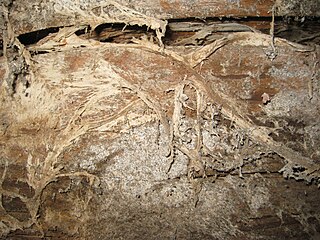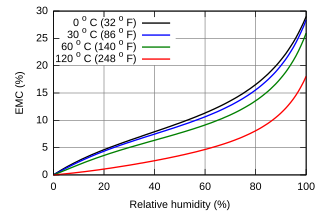
Pulp is a lignocellulosic fibrous material prepared by chemically or mechanically separating cellulose fibres from wood, fiber crops, waste paper, or rags. Many kinds of paper are made from wood with nothing else mixed into them. This includes newspapers, magazines and even toilet paper. Pulp is one of the most abundant raw materials.

Relative humidity (RH) is the ratio of the partial pressure of water vapor to the equilibrium vapor pressure of water at a given temperature. Relative humidity depends on temperature and the pressure of the system of interest. The same amount of water vapor results in higher relative humidity in cool air than warm air. A related parameter is that of dewpoint.

Medium-density fibreboard (MDF) is an engineered wood product made by breaking down hardwood or softwood residuals into wood fibres, often in a defibrator, combining it with wax and a resin binder, and forming panels by applying high temperature and pressure. MDF is generally denser than plywood. It is made up of separated fibres, but can be used as a building material similar in application to plywood. It is stronger and much denser than particle board.
A paper machine is an industrial machine used in the pulp and paper industry to create paper in large quantities at high speed. Modern paper-making machines are based on the principles of the Fourdrinier Machine, which uses a moving woven mesh to create a continuous paper web by filtering out the fibres held in a paper stock and producing a continuously moving wet mat of fibre. This is dried in the machine to produce a strong paper web.

Moisture is the presence of a liquid, especially water, often in trace amounts. Small amounts of water may be found, for example, in the air (humidity), in foods, and in various commercial products. Moisture also refers to the amount of water vapour present in the air.
Bottles made of polyethylene terephthalate can be used to make lower grade products, such as carpets. To make a food grade plastic, the bottles need to be hydrolysed down to monomers, which are purified and then re-polymerised to make new PET. In many countries, PET plastics are coded with the resin identification code number "1" inside the universal recycling symbol, usually located on the bottom of the container.

A log house, or log building, is a structure built with horizontal logs interlocked at the corners by notching. Logs may be round, squared or hewn to other shapes, either handcrafted or milled. The term "log cabin" generally refers to a smaller, more rustic log house, such as a hunting cabin in the woods, that may or may not have electricity or plumbing.
Retting is a process employing the action of micro-organisms and moisture on plants to dissolve or rot away much of the cellular tissues and pectins surrounding bast-fibre bundles, and so facilitating separation of the fibre from the stem. It is used in the production of fibre from plant materials such as flax and hemp stalks and coir from coconut husks.

Water content or moisture content is the quantity of water contained in a material, such as soil, rock, ceramics, crops, or wood. Water content is used in a wide range of scientific and technical areas, and is expressed as a ratio, which can range from 0 to the value of the materials' porosity at saturation. It can be given on a volumetric or mass (gravimetric) basis.

Dry rot is wood decay caused by certain species of fungi that digest parts of the wood which give the wood strength and stiffness. It was previously used to describe any decay of cured wood in ships and buildings by a fungus which resulted in a darkly colored deteriorated and cracked condition.
Drying is a mass transfer process consisting of the removal of water or another solvent by evaporation from a solid, semi-solid or liquid. This process is often used as a final production step before selling or packaging products. To be considered "dried", the final product must be solid, in the form of a continuous sheet, long pieces, particles or powder. A source of heat and an agent to remove the vapor produced by the process are often involved. In bioproducts like food, grains, and pharmaceuticals like vaccines, the solvent to be removed is almost invariably water. Desiccation may be synonymous with drying or considered an extreme form of drying.

Soil moisture sensors measure the volumetric water content in soil. Since the direct gravimetric measurement of free soil moisture requires removing, drying, and weighting of a sample, soil moisture sensors measure the volumetric water content indirectly by using some other property of the soil, such as electrical resistance, dielectric constant, or interaction with neutrons, as a proxy for the moisture content.

Moisture meters are used to measure the percentage of water in a given substance. This information can be used to determine if the material is ready for use, unexpectedly wet or dry, or otherwise in need of further inspection. Wood and paper products are very sensitive to their moisture content. Physical properties are strongly affected by moisture content and high moisture content for a period of time may progressively degrade a material.
Dynamic vapor sorption (DVS) is a gravimetric technique that measures how quickly and how much of a solvent is absorbed by a sample: such as a dry powder absorbing water. It does this by varying the vapor concentration surrounding the sample and measuring the change in mass which this produces. Water vapor is most commonly used, but it is also possible to use a wide range of organic solvents.

Water activity or aw is the partial vapor pressure of water in a substance divided by the standard state partial vapor pressure of water. In the field of food science, the standard state is most often defined as the partial vapor pressure of pure water at the same temperature. Using this particular definition, pure distilled water has a water activity of exactly one. As temperature increases, aw typically increases, except in some products with crystalline salt or sugar.
Green woodworking is a form of wood craft or in broad terms, carpentry, that works unseasoned or "green" timber into finished items. Unseasoned wood is wood that has been freshly felled or preserved by storing it in a water-filled trough or pond to maintain its naturally high moisture content. Green wood is much softer than seasoned timber and is therefore much easier to shape with hand tools. As moisture leaves the unseasoned wood, shrinkage occurs and the green woodworker can use this shrinkage to ensure tight joints in their work. To enhance the effect of the shrinkage, one half of a joint may be forcibly over-dried in a simple kiln while its encapsulating component is left green. The components tighten against each other as the parts exchange moisture and approach equilibrium with the surrounding environment. The swelling of the dry tenon inside the shrinking “green” mortise makes for an incredibly tight and permanent joint despite a lack of adhesives. Bodging is a traditional green woodworking occupation, where chair components were made in the woods and exported to workshops where the complete chairs were assembled by furniture makers. Green woodworking has seen a recent revival due to its increased media coverage and the renaissance of hand tool woodworking in general.
DPHM-RS is a semi-distributed hydrologic model developed at University of Alberta, Canada.
Grain drying is process of drying grain to prevent spoilage during storage. The grain drying described in this article is that which uses fuel- or electric-powered processes supplementary to natural ones, including swathing/windrowing for drying by ambient air and sunshine.











